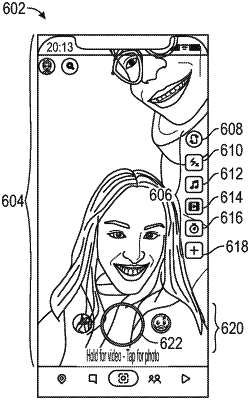| CPC G06F 3/04817 (2013.01) [G06F 3/0482 (2013.01); G06F 3/04845 (2013.01); G06F 3/04847 (2013.01); H04N 23/632 (2023.01); H04N 23/667 (2023.01)] | 11 Claims |

|
1. A method, comprising:
selecting a subset of camera modes from among a set of camera modes for applying to an image captured by a device camera, the set of camera modes including a multiple media content item mode for capturing multiple media content items at once and editing the multiple media content items;
wherein the selecting is based at least in part on user history with respect to activating the subset of camera modes;
causing display of a first interface for presenting the subset of camera modes, the first interface including a group of icons, each of which is user-selectable to activate a respective camera mode within the subset of camera modes, the first interface further including an additional icon which is user-selectable to switch to a second interface;
causing, in response to user selection of an icon within the group of icons, display of a respective widget as an overlay on the first interface, the respective widget including user-selectable options for specifying parameters for the camera mode corresponding to the user-selected icon;
causing, in response to user selection of the additional icon, display of the first interface to switch to display of the second interface for presenting the set of camera modes, the second interface including a list of entries, each of which is user-selectable to activate a respective camera mode within the set of camera modes; and
causing, in response to user selection of an entry within the list of entries,
display of the second interface to switch back to display of the first interface, and
display of a respective widget as an overlay on the first interface, the respective widget including user-selectable options for specifying parameters for the camera mode corresponding to the user-selected entry.
|